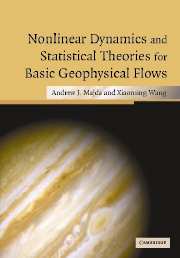Book contents
- Frontmatter
- Contents
- Preface
- 1 Barotropic geophysical flows and two-dimensional fluid flows: elementary introduction
- 2 The response to large-scale forcing
- 3 The selective decay principle for basic geophysical flows
- 4 Non-linear stability of steady geophysical flows
- 5 Topographic mean flow interaction, non-linear instability, and chaotic dynamics
- 6 Introduction to information theory and empirical statistical theory
- 7 Equilibrium statistical mechanics for systems of ordinary differential equations
- 8 Statistical mechanics for the truncated quasi-geostrophic equations
- 9 Empirical statistical theories for most probable states
- 10 Assessing the potential applicability of equilibrium statistical theories for geophysical flows: an overview
- 11 Predictions and comparison of equilibrium statistical theories
- 12 Equilibrium statistical theories and dynamical modeling of flows with forcing and dissipation
- 13 Predicting the jets and spots on Jupiter by equilibrium statistical mechanics
- 14 The statistical relevance of additional conserved quantities for truncated geophysical flows
- 15 A mathematical framework for quantifying predictability utilizing relative entropy
- 16 Barotropic quasi-geostrophic equations on the sphere
- Index
14 - The statistical relevance of additional conserved quantities for truncated geophysical flows
Published online by Cambridge University Press: 30 November 2009
- Frontmatter
- Contents
- Preface
- 1 Barotropic geophysical flows and two-dimensional fluid flows: elementary introduction
- 2 The response to large-scale forcing
- 3 The selective decay principle for basic geophysical flows
- 4 Non-linear stability of steady geophysical flows
- 5 Topographic mean flow interaction, non-linear instability, and chaotic dynamics
- 6 Introduction to information theory and empirical statistical theory
- 7 Equilibrium statistical mechanics for systems of ordinary differential equations
- 8 Statistical mechanics for the truncated quasi-geostrophic equations
- 9 Empirical statistical theories for most probable states
- 10 Assessing the potential applicability of equilibrium statistical theories for geophysical flows: an overview
- 11 Predictions and comparison of equilibrium statistical theories
- 12 Equilibrium statistical theories and dynamical modeling of flows with forcing and dissipation
- 13 Predicting the jets and spots on Jupiter by equilibrium statistical mechanics
- 14 The statistical relevance of additional conserved quantities for truncated geophysical flows
- 15 A mathematical framework for quantifying predictability utilizing relative entropy
- 16 Barotropic quasi-geostrophic equations on the sphere
- Index
Summary
Introduction
A major theme of Chapters 6–13 of this book is to illustrate that systematic application of ideas from equilibrium statistical mechanics leads to novel promising strategies for assessing the unresolved scales of motion in geophysical flows. The various theories range from the simplest energy–enstrophy statistical theory (EEST) discussed in Chapters 6 and 8 to the empirical statistical theories discussed in Section 9.4 attempting to encode all the conserved quantities (ESTMC), to point vortex statistical theories discussed in Section 9.3, and, finally, to the empirical statistical theories with a few large-scale constraints and a judicious small-scale prior distribution (ESTP) formulated in Section 9.2. It was established in Chapters 11, 12, and 13 that the ESTP theories have a wide range of applicability in predicting large-scale behavior in damped and driven flows, as well as for observations such as the Great Red Spot of Jupiter. The ESTP formulation also includes the predictions of the energy–enstrophy statistical theory for the mean flow from Chapters 6 and 8 by utilizing a simple Gaussian prior probability distribution for potential vorticity fluctuations.
As discussed earlier, in Chapters 8, 9, and 10, the different equilibrium statistical theories all attempt to predict the coarse-grained behavior at large scales through the use of some of the formally infinite list of conserved quantities for idealized geophysical flows derived in Chapter 1.
- Type
- Chapter
- Information
- Publisher: Cambridge University PressPrint publication year: 2006



